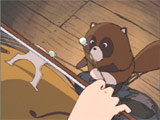

Quick Links:
Gauche the Cellist
Before the critically acclaimed Grave of the Fireflies and before Studio Ghibli released its first film, director Isao Takahata did a charming little film about a young musician's life-changing 10-day experience. Gauche the Cellist mixes a little music and a little imagination to tell a tale of discovering one's own character, with the help of a few friends. Even though it's more than 20 years old, this is a film that has aged gracefully enough to still be very much worth watching today.
Gauche the Cellist was released in 1981 and clocks in at a mere 63 minutes. From the title, one can guess what the main character's name is, and what instrument he plays. He participates in a local orchestra that is preparing for a concert that's 10 days away. The conductor isn't too happy with the way practice is going, and he identifies Gauche as the weak point and tells him to improve himself.
Improving proves difficult for Gauche, because he's going about it all wrong - but four unexpected visitors change all that. The first is a cat who asks him to play something different than the piece he's practicing. The next is a bird who asks him to teach it a scale. The third visitor is a tanuki that asks to tune with him. (A tanuki is somewhat like a raccoon, but isn't. The word is often mistranslated as raccoon or badger.) The last visitor is a rat who asks Gauche to cure her sick child.
Each animal that visits Gauche represents a facet of his performances that needs improvement. This construct works well for the film, giving it the feel of a fable in addition to being a story about personal growth. The story also stresses the idea of mutual benefit - that you always get something out of giving. It's not a character-centric story. The ideas expressed in the film are more important than the feelings of the characters. You probably wouldn't develop an emotional attachment to it, but you probably would learn something valuable from it.
For an animated movie, Gauche the Cellist is old. And it looks it. The characters were well-drawn and colored nicely (even by today's standards), but the animation doesn't show its age as well. Its age shows the most in weather effects like rain and wind, and in how the character drawings don't always gel with the backgrounds. It certainly doesn't cause a problem with the viewing experience though, since the quality of the overall work is high enough to compensate for the fact that animation was still a very young field of practice in the early 1980s.
The music of Gauche the Cellist still has appeal today, though the quality of the recording puts a damper on that. It's mostly string music, with a small assortment of brass and woodwinds backing up. Single instrument performances recorded well, but the full range of the orchestral performances were not captured too well in the recording. Nevertheless, the music itself is excellent, and had to be for a film that centered around music.
Gauche the Cellist is simple and sweet. It won't blow your mind. You won't have pictures of the characters on your wall or any hentai doujinshi including them (at least, I hope not). But you will likely get something positive out of watching this film, and it's a good way of seeing how far director Takahata and Studio Ghibli have come.
Distributor: Walt Disney Home Entertainment Creator: Isao Takahata / OH Production Released: 1981
Plot: B+ Character Design: B Animation Quality: B Music: A Overall: B



